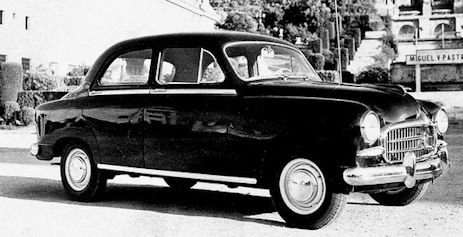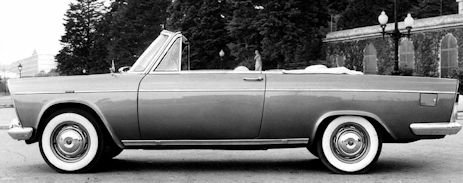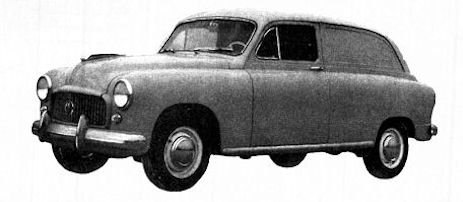Seat 1400
 |
|
|
Production period: |
1953 to 1964 |
|
Class : |
Motor car |
|
Body versions : |
Van,station wagon,sedan |
|
Engines: |
Petrol : in line 4 with 1.4 liters |
| Wheel base: | 104.33 in, 2650 mm |
| Length: | 175.79 in,4465 mm |
| Width: | 63.78 in, 1620 mm |
| Ground clearance: | 6.7 in, 170 mm |
The Seat 1400 is a mid- size car . It was the first vehicle from Seat, which was manufactured from 13 November 1953 produced under a Fiat license between 1953 and 1964 . It was the first vehicle assembled by the brand in Barcelona
The parts of the Fiat 1400 corresponding car were made in Italy, where the assembly took place in Spain. The vehicle was equipped with a series four-cylinder petrol engine, which developed a capacity of 44 CUNA-PS from 1395 cc . Its top speed was 116 km / h.This SEAT 1400 was identical to the Fiat 1400/1900 (type 101) of 1950, the first model with monocoque body built by the Italian brand, and had a body type "Pontoon" with rounded lines, inspired by the American cars of the time. The successive versions of it were: 1400, 1400 A, 1400 B, and 1400 C. The 1400 had a saloon type body, but family versions were also presented (5 doors), glazed or closed (van), elongated (limousine), ambulances, funerals, and the Sport Spider cabriolet (designed by the Catalan coachbuilder Pedro Serra).
The original 1400 was only manufactured for one year, from May 1953 to May 1954 . This body at the beginning did not have a large number of chrome, which were increasing in number and size as the years passed and the versions. It also featured in optional with versions with black, red or white roof.Being only one year in the production line, the units manufactured were very scarce, some 2114. The engine was a 4 cylinders in line of 1.395 cc cooled by water, which developed 44 CV, which allowed this first version reach a top speed of 120 km / h.
In 1955 it was replaced by the Seat 1400 A and now completely made in Spain. Similar to the Fiat 1400 A, the engine output also increased to 50 CUNA-HP, with the maximum speed now being set at 125 km / h and the power to 50 HP. In this version more chrome were added, the optical groups of the rear part were replaced and the rear window was enlarged, among other modifications. Between 1954 and 1960 it was produced 30,990 units SEAT 1400 A.
From December 1956. the Seat 1400 B was built. As with the Fiat counterpart, the engine output now increased to 58 CUNA-PS, with the vehicle it brought to 135 km / h. It had a design more similar to that of American cars and some more chrome than its predecessor.
As of 1958, the 1400 B Special, the last variant of the SEAT 1400 manufactured with the initial bodywork, experienced another new power increase until reaching 58 HP when finally adopting the propeller of the original Fiat 1400 B, allowing it to develop now the 135 km / h. The instrument panel of this car was also adopted, with the horizontal tape speedometer, which earned it the popular nickname of "Mercurio" (due to the similarity with the reading bar of the thermometers). Between 1956 and 1959, 17,053 units of the 1400 B and 1400 B Special were produced. In optional, it had two-color paint in different combinations, giving it a more striking and at the same time elegant appearance.

1959 appeared the Seat Corver 1400 Cabriolet . The coachbuilder SERRA produced the two-door Cabriolet in Frua style with panoramic windshield, leather trim and air scoops on the hood only in small quantities on customer order.
1960 1400 B was the more modern seat 1400 C replaced. This had the same engine and the same suspension as the 1400 B, but he distinguished himself from this by the trapezoidal body of the Fiat 1800 . In addition to the sedan, a five-door station wagon (Familiar, from 1963), a two-seat box van with left rear discs (Fúgon) and a pick-up were offered. The coachbuilder ONECA also built a six-seater sedan. Four cylinders, 1395 cm3, 82 x 66 mm, 44 HP / 50 HP / 58 HP, A Solex / Weber 36 DAD1 carburetor with automatic starter, only in model C.
PERFORMANCE: 1400 C
- Engine capacity: 85.32 cu in, 1395 cu cm
- Fuel consumption: 28.2 m/imp gal, 23.5 m/US gal, 10 1 x 100 km;
- Max speed: 83.9 mph, 135 km h;
- Max power (DIN): 58 hp at 4600 rpm
- Max torque (DIN):65 1b ft, 9 kgm at 3700 rpm
- Max number of engine rpm: 4800
- Power-weight ratio: 40.4 lb/hp,18.3 kg/hp
In early 1964, the Seat 1400 C was discontinued in favor of the successor Seat 1500 . A diesel engine, as in the Italian model, but there was not the Seat.
The SEAT 1400 C was commercialized from its introduction in 1960 until 1964 after a short coexistence with its successor the SEAT 1500 Despite sharing the name with the SEAT 1400 A and B, the 1400 C belonged to the family of the Fiat 1800/2100 , successors of the Fiat 1400/1900 on which they were based.
With the discontinuation of production in Italy of the type 101 -Fiat 1400 and 1900- to be replaced by the new type 112 -Fiat 1800 and 2100-, Fiat developed for SEAT a four-cylinder variant specific to the new type 112 as part of the agreement of manufacturing. This variant used the largest possible number of components already in production at the Barcelona factory, so it used the entire front set of the old 101 adapted to the new chassis. The front bridge maintained the spring suspension of the 1400 B on which the four-cylinder 101A engine of the Fiat 1400 B Especial was initially incorporated along with an adapted transmission and a simplified rear bridge with transmission brake, the first version being four cylinders on this body. In spite of being a completely new model, the denomination 1400 regarding the displacement was maintained, with the surname "C" in congruence with the previous series.
The gearbox 4 speeds with the three highest synchronized, and reverse with lever on the steering column.Schematic Hotchkiss formed by two axes, the first coupled to the change by means of flexible joint and support at the opposite end to a cylindrical roller bearing, the second coupled to the first and to the rear bridge by cardan joints. Suspension Front, double triangles forming a deformable parallelogram, coil spring springs, double-acting hydraulic telescopic shock absorbers and stabilizer bar.Rear, rigid axle with semicantilever ballestines making reaction and push arms, heicoidal springs as spring, double-acting telescopic hydraulic shock absorbers, double rail guide bar anchored to the bridge and on L-profiles to the chassis (panhard bar in 1400 C), anti-roll effect provided by the leaf springs themselves.Hydraulic drum on all four wheels, by hand acting on the transmission ,the distribution of weight: 55.41 % at the front axle, and 44.59 % to rear axle.
Like Fiat with the 1500 L a year before, SEAT incorporated in 1963 the engine of 1481 cc, from the new Fiat 1300/1500 to its own variant. This, together with a discrete series of improvements, meant the change of denomination to "SEAT 1500", in reference to the new mechanics.
His "American" line, designed by the engineer Dante Giacosa , left the pontoon lines of the Fiat / SEAT 1400 A / B in favor of the Italian design trend of the late 50's in vogue with the experimental Lancia Florida of 1955 bodywork by Pininfarina and its production version, the Lancia Flaminia ( Pininfarina , Turin 1957), resulting very similar to the recent Alfa Romeo 2000 ( Carrozzeria Touring , Milan 1957).
The engine was already 25% more power than in the original 1400 and at the time was not as inframed as it might seem from a current perspective, because the power was even higher than similar European models such as the Opel Rekord 1500 ( 50 CV DIN) or Ford Taunus 17 M (55 HP DIN). It began to be sold in February 1960 at a price of 160,000 pts (with some delay on the forecasts for the late arrival of parts from Italy) and in total, 47,284 units of the SEAT 1400 C were produced, adding to it the (1,602 units of the family version).
Prototypes and Derivatives
- SEAT 1400 Sport (1959).
- SEAT 1400 Microbús (1957), It was shown at the Trade Fair of
- SEAT 1400 Sport cabriolet bodied by Serra
SEAT 1400 7 It was a modified 1400 B, without roof or doors, special for SEAT visits. Of this model only 2 units were manufactured.
Different bodies were derived, such as the elongated one, the van of commercial type (closed) and tourism (glazed) and also adaptations to provide services such as taxi, ambulance, police or funeral cars. Some of these derivatives, mainly those destined for taxi, were fitted with diesel engines from Barreiros , the mechanical ones were named as (EB-55, C14 and C24).
The bodybuilder and designer Pedro Serra made several recarrozados or adaptations from the three versions, especially cabriolet bodies.
There was a derivative with closed box type bodywork designed by the Hugas bodybuilder of Sant Adrià de Besò called Fugón Hugas. It appeared in 1957 and remained in production until 1960.

Technical
-
Seat 1400 Technical details and specifications (1953-1964)
ENGINE: 1400
location front, 4 stroke
cylinders: 4, in line, vertical
bore and stroke: 3.23 x 2.60 in, 82 x 66 mm
engine capacity: 85.32 cu in, 1395 cu cm
compression ratio: 7.5 : 1
specific power: 41 hp/l
cylinder block: cast iron
cylinder head: light alloy
crankshaft bearings: 3
valves: 2 per cylinder, overhead, with push rods and rockers
camshaft: 1, side
lubrication: gear pump, filter on by-pass
carburation: 1 Weber 36 DAD 1 downdraft twin barrel carburettor
fuel feed: mechanical pump
cooling system:waterTRANSMISSION:
driving wheels: rear
clutch: single dry plate, hydraulic drive
gear box: mechanical; gears: 4+ reverse
gear box ratios: (I) 3.86, (II) 2.38, (III) 1.57, (IV) 1, (Rev) 3.86
gear lever: steering column
final drive: hypoid, bevel ratio: 4.4:1.CHASSIS:
integral; front suspension: independent, wishbones, coil springs,anti-roll bar, telescopic dampers
rear suspension: rigid axle, 1/4-elliptic leaf-springs as trailing radius arms, transverse bar linkage, coil springs telescopic dampers.BRAKES:
drum, 2 front leading shoes
braking surface: front 80.13 sq in,517 sq cm
braking surface: rear 80.13 sq in, 517 sq cm
braking surface: total 160.26 sq in, 1034 sq cmELECTRICAL EQUIPMENT:
voltage: 12 V
battery: 55 Ah
dynamo: 300 W
ignition distributor: Femsa D 41-17DIMENSIONS AND WEIGHT:
wheel base: 104.33 in, 2650 mm
front track:52.36 in, 1330 mm
rear track: 51.42 in, 1306 mm
overall length: 175.79 in,4465 mm
overall width: 63.78 in, 1620 mm
overall height: 56.38 in, 1431 mm
ground clearance: 6.7 in, 170 mm
dry weight: 2523 1b, 1144 kg
distribution of weight: 55.41 0/0 front axle, 44.59 0/0 rear axle
turning radius (between walls):17.7 ft, 5.4 m© Motor car History
Service
-
Seat 1400 Maintenance and Service Guide (1953-1964)
Fuel: petrol, 92 Oct
Engine sump oil: 3.71 imp qt, 4.49 US qt, 4.25 1, SAE 30 (winter) 40 (summer), change every 1900 miles,3000 km
Total lubricating system capacity: 4.4 imp qt, 5.3 US qt
Gearbox oil:1.5 imp qt, 1.8 US qt. 1.7 1, SAE 90, change every 12400 miles, 20000 km
Final drive oil: 1.32 imp qt, 1.59 US qt, 1.5 1, SAE 90, change every 12400 miles, 20000 km
Steering box oil: 0.16 imp qt, 0.18 US qt, 0.18 1, SAE 90
Cooling system capacity: 8.8 imp qt, 9.8 US qt
Greasing: every 1600 miles, 2500 km, 10 points
Tappet clearances: inlet 0.006 in, 0.15 mm, exhaust 0.006 in, 0.15 mm
Valve timing: (inlet) opens 15° before tdc and closes 55° after bdc, (exhaust) opens 48° before bdc and closes 10° after tdc
Tyre pressure (normal load): front 23 psi, 1.6 atm, rear 25 psi, 1.7 atm.
Tyres: 5.90 - 14
Fuel tank capacity: 13.19 imp gal, 15.85 US gal© Motor car History
